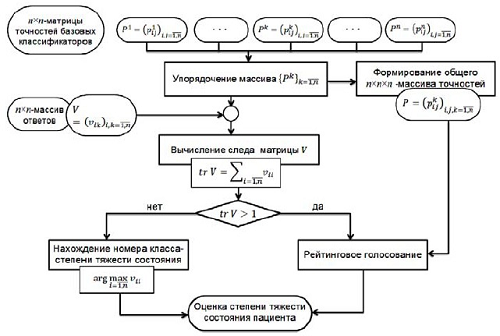Информационная технология оценки степени тяжести состояния пациентов
DOI:
https://doi.org/10.15587/2313-8416.2014.27256Ключевые слова:
информационная технология, оценка тяжести состояния пациента, классификация с обучением, композиции (комитеты, ансамбли) классификаторовАннотация
В работе предложена информационная технология оценки степени тяжести состояния пациентов, основанная на разработанных автором методе классификации с обучением и методах построения ансамблей классификаторов. Приведены результаты использования информационной технологии на реальных данных при оценке тяжести состояния 232 пациентов с травматическими повреждениями поджелудочной железы.
Библиографические ссылки
1. Fleming, W. R., Collier, N. A., Banting, S. W. (1999). Pancreatic trauma: Universities of Melbourne HPB Group. Aust. N. Z. J. Surg., Vol. 69, No. 5, 602–605.
2. Potanina, O. K., Dorfman, A. G., Shvyrev, S. L., Zarubina, T. V., Petrova, M. V. (2011). The experience of using foreign diagnosis nonspecific prognostic models for patients of surgical and oncological profiles. Vestnik RNCRR (Journal (Herald) of RSCRR), 3, 74–85.
3. Tyurin, A. S. (2013). Prediction and assessment of the quality of treatment for patients with fractures of the pelvis with associated trauma, 18.
4. Ivanov, P. A., Grishin, A. V., Korneev, D. A., Zinyakov, S. A. (2003). Injuries of pancrea-duodenal organs. Hirurgiya (Surgery). Juranal imeni N. I. Pirogova, 12, 39–40.
5. Vityuk, T. V., Domans’ky, B. V., Baramiya, N. A. (2002). Surgical treatment of open and closed pancreas injuries. Problemy viyskovoi ohorony zdorov’ya, 11, 387–395.
6. Young, P. R., Meredith, J. W., Baker, C. C. (1998). Pancreatic injuries resulting from penetrating trauma: a multi-institution review. Am. Surg., 64 (9), 838–843.
7. Hannan, E. L., Farrell, L. S., Gorthy, S. F. (1999). Predictors of mortality in adult patients with blunt injuries in New York State: a comparison of the Trauma and Injury Severity Score (TRISS) and the International Classification of Disease, Ninth Revision-based Injury Severity Score (ICISS), 47 (1), 8–14.
8. Yaroshetskiy, A. I. (2006). Integrated assessment of patients’ state and prognosis in a case of severe multi-trauma, 26.
9. Nessonova, M. N. (2014). The method to develop classifiers based on geometrical interpretation of data structure. Actual’ni pytannya pharmacevtychnoi I medychnoi nauky i praktiki, 1 (14), 101–103.
10. Nessonova, M. N. (2013). Metric approach based classifier. Book of abstracts of all-Ukrainians scientific and practical conference of students and young scientists «Actual questions of development of new medicines», 269.
11. Nessonova, M. N. (2013). The rate voting of mixture of experts algorithm in supervised classification problems. Zaporozhskiy medicinskiy zhurnal, 1 (76), 101–102.
12. Nessonova, M. N., Kochina, M. L. (2014). Methods to estimate patient’s grade of severity. Kibernetika i vychislit’l'naya tehnika, 175, 74—87.
13. Djuk, V. A. (2002). Smithereens of knowledge. Express-Electronics, 6, 60–65.
14. Lbov, G. S., Pestunova, T. M. (1985) Grouping objects in heterogeneous featured space (in Non-numerical information analysis in social science), 226.
15. Vorontsov, K. V. (2012). Lecture notes on logical classification algorithms. Available at: http://www.ccas.ru/voron/download/LogicAlgs.pdf.
16. Aivazyan, S. A., Buchstaber, V. M., Yenyukov, I. S., Meshalkin, L. D. (1989). Applied statistics: Classification and reduction of dimensionality: Reference Edition. Moscow: Financy i statistika, 607.
17. Kuncheva, L. I. (2004). Combining pattern classifiers: methods and algorithms. Hoboken, New Jersey: A Wiley- Interscience publication, 360.
18. Osborne, M. L. (1977). The seniority logic: A logic for a committee machine. IEEE Trans. on Comp., Vol. C-26, No. 12, 1302–1306.
19. Congalton, R. G. (1991). A review of assessing the accuracy of classifications of remotely sensed data. Remote Sens. Environ., 37, 35–46.
20. Nessonova, M. N., Kochina, M. L. (2013). Applying results of the information technology for grade of severity estimation and clinical outcome prediction in a case of pancreas trauma. Clinical Informatics and Telemedicine, 10 (9), 102–107.

Загрузки
Опубликован
Выпуск
Раздел
Лицензия
Copyright (c) 2014 Марина Николаевна Нессонова

Это произведение доступно по лицензии Creative Commons «Attribution» («Атрибуция») 4.0 Всемирная.
Наше издание использует положения об авторских правах Creative Commons CC BY для журналов открытого доступа.
Авторы, которые публикуются в этом журнале, соглашаются со следующими условиями:
1. Авторы оставляют за собой право на авторство своей работы и передают журналу право первой публикации этой работы на условиях лицензии Creative Commons CC BY, которая позволяет другим лицам свободно распространять опубликованную работу с обязательной ссылкой на авторов оригинальной работы и первую публикацию работы в этом журнале.
2. Авторы имеют право заключать самостоятельные дополнительные соглашения, которые касаются неэксклюзивного распространения работы в том виде, в котором она была опубликована этим журналом (например, размещать работу в электронном хранилище учреждения или публиковать в составе монографии), при условии сохранения ссылки на первую публикацию работы в этом журнале .
